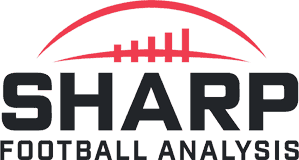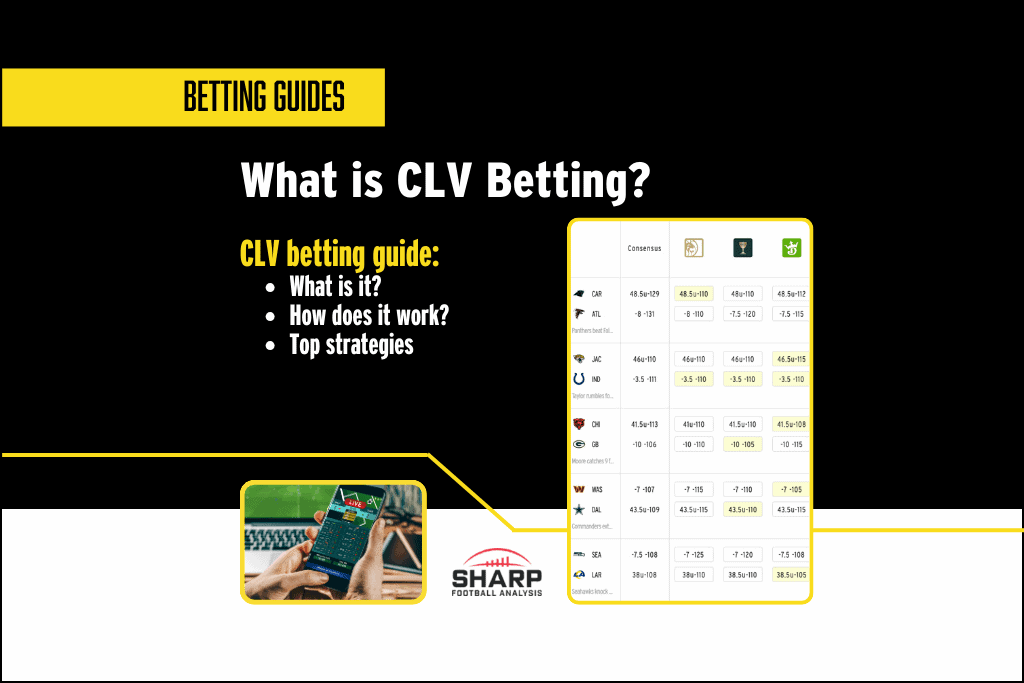CLV (Closing Line Value) betting is a sports betting strategy most common in the United States that measures the difference between your bet odds and the closing line odds just before a game starts in 2025. Getting positive CLV means you secured better odds than the final market price, giving you long-term betting value and higher profit potential.
- What is CLV?: Closing Line Value – difference between your bet odds and final market odds
- Best CLV Strategy: Shop multiple sportsbooks + bet early on sharp line movements
- CLV Profit Potential: 2-5% edge over closing lines = 15-25% annual ROI improvement
- Top CLV Sports: NFL spreads, NBA totals, MLB moneylines, Soccer Asian handicaps
Contents
If you've been wagering on sports for a while, you've probably noticed how betting lines bounce around in the days before the game. Smart bettors often discuss “getting the best of the number” or “beating the closing line.” Put simply, they're talking about the CLV, AKA Closing Line Value. Professional bettors use CLV as their primary success metric because it indicates long-term profitability better than win-loss records. Let's break down what CLV betting is all about and how to beat the closing lines in December 2025.
What is CLV Betting? | Intro to the Closing Line Value
Closing Line Value betting is the practice of securing better odds than the final market price to maximize long-term betting profits in 2025. CLV is expressed either as a difference in points/spreads or as the variance in implied probability for moneyline bets.
CLV Betting Glossary: Essential CLV Terms
Before we deep dive into CLV strategy, it pays to know the relevant lingo. Here are the essential sports betting terms to get you started:
Opening Line
The first odds a sportsbook puts out for a game is the “opening line.” Opening lines are often set days or even weeks before an event. For NFL games, for instance, you might see opening lines pop up on Sunday night for next week's games. College football sometimes releases early lines for games months in advance. On the other hand, opening lines for NBA and college basketball games are typically released on the day of the game or the day before.
Closing Line
The closing line is the final odds available right before a game starts. Usually, these are the most accurate because oddsmakers have shaped them and then by sharp money throughout the week. Additionally, they factor in all the information released during the week, such as injury updates or weather conditions.
Line Movement
As we mentioned above, betting odds change between opening and closing based on betting action and new information. Like currency or stock prices, lines fluctuate based on incoming money and new information hitting the market. Savvy bettors know when to pounce on line movements at the right time.
Positive CLV
A positive CLV happens when you get more value for a bet relative to the closing line value. Let's say you bet on the LA Rams to cover a +5 spread on Tuesday. If the line is +6 by kickoff on Sunday, you've got 1 point of positive CLV (you got a better number than the closing line). In moneyline terms, getting +150 when the line closes +130 means you locked in an extra $20 of value on a successful $100 bet.
Negative CLV
Negative CLV occurs when you place a bet at worse odds than the closing line. An example of this would be wagering on the Dallas Cowboys to cover at -7 early in the week, only to watch the line drop to -5.5 by kickoff. For your -7 bet to be successful, the Cowboys would need to win by more than 7 points. If you had wagered at the right time to get -5.5, they would only have needed to win by 6 points.
Examples of CSV Bets in Football
Here are real-world CLV betting examples showing how to capture value across different sports and bet types in 2025.
CLV Example 1: NFL Point Spread
- Scenario: The Buffalo Bills open as a -5.5 favorite against the Jets on Monday Night Football. You notice some respected bettors taking the Bills early, so you also grab -5.5 (-110). Throughout the week, news breaks that the Jets' starting corner is out.
- Line Movement: News breaks that the Jets' starting corner is out. More money pours in on Buffalo, pushing the line to -7 by kickoff.
- CLV Result: You secured 1.5 points of positive CLV. Your ticket is at -5.5 while others are laying -7.
That 1.5 points of CLV is huge in NFL betting, where so many games land close to the spread number. Even if Buffalo wins by precisely 6 points, you win while -7 bettors push.
CLV Example 2: NFL Moneyline
Let’s say the Tampa Bay Bucs open at -150 on the moneyline against the New Orleans Saints. You hear whispers that the Saints' starting quarterback, Derek Carr, might be dealing with a thumb injury, so you jump on the Bucs early. Sure enough, a day later, Carr is ruled out, and the moneyline jumps to -180, which means on a $100 bet, you secured $11 of value ($66.67 instead of $55.56 in profits).
SFA betting tip: Track your CLV on every bet you place, win or lose. After 100+ bets, you'll start seeing patterns in which types of bets consistently give you the best closing line value.
Why is the CLV Important? | Benefits of CLV Betting
Beating the closing line is more important than you think. The final odds are usually the sharpest, most accurate you'll see. The market has had time to sort itself out, the smart money has come in, and all the important info is baked into the price.
CLV is a long-term success indicator that tells you more about your betting strategy than your win-loss record. You might get lucky and win a few bets with bad numbers, but consistently beating the closing line over hundreds of bets is no accident. Sharp bettors know that if you consistently get better numbers than the closing line, profits will follow.
Not all line movements are the same. A half-point move in an NFL game when crossing key numbers (like 3 or 7) is worth way more than a full-point move in college basketball. Smart bettors pick their spots and place more emphasis on significant line movements.
Multiple sportsbook accounts equal more CLV opportunities. Having accounts at different books lets you:
- Grab the best number available at any time
- Take advantage of books that are slow to move their lines
- Jump on odds before they get in line with the market
- Shop for the best price instead of settling for what one sportsbook offers
Let's say you grab the Patriots at -2.5 on Tuesday, and by Sunday kickoff, the line's moved to -4. Even if New England doesn't cover, you have still made a solid bet compared to those who bet the closing line because you got the better number. Do this consistently, and you're playing the game like the pros do, consistently giving yourself a higher likelihood of winning bets.
Best US Sportsbooks for CLV Betting in December 2025
The top sportsbooks for football CLV betting in 2025offer competitive opening lines, slow line movement, and multiple football markets for maximum line shopping opportunities.
Top CLV Betting Sites Comparison
Here's how they stack up:
| Sportsbook | CLV Rating | Best Features | Opening Lines | Sign up |
|---|---|---|---|---|
| bet365 | ⭐⭐⭐⭐⭐ | Global markets, early lines | Very competitive | Place a bet |
| DraftKings | ⭐⭐⭐⭐ | Wide market selection | Good opening value | Place a bet |
| FanDuel | ⭐⭐⭐⭐ | Competitive NFL lines | Strong weekend openers | Place a bet |
| BetMGM | ⭐⭐⭐⭐ | Slow to move on some markets | Decent openers | Place a bet |
| Caesars | ⭐⭐⭐ | Promotional value | Average | Place a bet |
Pro tip: sign up with multiple sportsbooks. This increases your CLV betting opportunities because you can:
- Shop opening lines across all major books within minutes
- Take advantage of slow movers when news breaks
- Arbitrage differences between books before they align
- Access different market makers with unique pricing models
New users can get started with the BetMGM bonus code or the Bet365 bonus code, depending on legal state availability and odds.
Tips for CLV Betting
You can take a few steps to improve your ability to find CLV, but it's essential to understand why the odds shift. Sometimes, the reason is obvious (like when a star quarterback gets hurt), but other times, lines move because sharp bettors see something the public doesn't.
Take March Madness, for example. Smart money might pounce on a lower-seeded, mid-major 12-seed against a power-conference 5-seed because they ignored the name on the jerseys and focused on the efficiency numbers.
The main two keys for successful long-term CLV betting are:
- Keep multiple sportsbook accounts funded and ready: Different books will have different lines, and being able to shop around and lay money when the time is right is huge. Maybe DraftKings has the Rams at -3 (-110), but FanDuel is still sitting at -2.5 (-110). That half-point could be the difference between a win and a push.
- Watch how the money moves: If a line moves fast, there's usually a reason. Maybe sharp bettors know something you don't, or big news is about to drop. Following these movements can help you spot opportunities.

- Pro Tip: Utilize a CLV tracker app or spreadsheet to automate the calculation of your closing line value. Many sharp bettors consider CLV more important than their actual win-loss record because it predicts long-term profitability.
Common CLV Mistakes to Avoid
Even experienced bettors sometimes mess up when chasing CLV. In general, you won't always be able to find the best lines and odds throughout the week, even if you try. Chasing CLV can sometimes lead to making rash betting decisions.
Here are three things to avoid with CLV betting:
- Chasing line moves too late: If you're jumping on a line that's already moved three times, you're probably getting the worst of it.
- Ignoring context: Not all line moves are created equal. A half-point move in an NFL game means way more than the same move in an NBA total.
- Getting married to one book: Loyalty programs are nice, but not if they cost you better odds and lines elsewhere.


